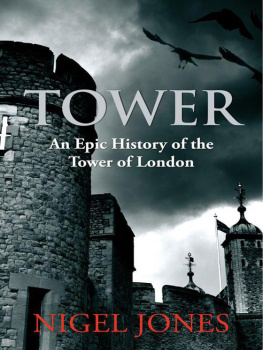CONTENTS
About the Book
Castle, royal palace, prison, torture chamber, execution site, zoo, mint, treasure house, armoury, record office, observatory and the most visited tourist attraction in the country: the Tower of London has been all these things and more. No building in Britain has been more intimately involved in our island's story than this mighty, brooding stronghold in the very heart of the capital, a place which has stood at the epicentre of dramatic, bloody and frequently cruel events for almost a thousand years.
Now historian Nigel Jones sets this dramatic story firmly in the context of national and international events. In a gripping account drawn from primary sources he pictures the Tower in its many changing moods and its many diverse functions. Here, for the first time, is a thematic portrayal of the Tower of London not just as an ancient structure but as a living symbol of the nation.
Incorporating a dazzling panoply of political and social detail, Tower puts one of Britain's most important buildings firmly at the heart of our national story.
About the Author
Nigel Jones is a former deputy editor of History Today and BBC History magazines who is now a full-time historian and biographer. He has written books on subjects as diverse as Rupert Brooke, Patrick Hamilton and Nazi Germany, appeared on historical documentaries on BBC TV and radio and written and reviewed for most national newspapers. He conducted the author interviews for the Daily Mail Book Club; and reads for serialisation for the Daily Mail. His reviews appear frequently in the Sunday Telegraph, Literary Review and History Today. Nigel is founder-director of www.historicaltrips.com
He lives near Brighton in East Sussex with his partner and three children.
Also by Nigel Jones
The War Walk: A Journey Along the Western Front (Robert Hale, 1984)
Hitlers Heralds: The Story of the Freikorps 191823 (John Murray, 1987)
Through a Glass Darkly: The Life of Patrick Hamilton (Macdonalds/Scribners, 1991)
Rupert Brooke: Life, Death and Myth (Richard Cohen Books/Metro, 1999)
Mosley (Haus, 2004)
Countdown to Valkyrie: The July Plot to Kill Hitler (Frontline, 2008)
ACKNOWLEDGEMENTS
My first appreciations must go to the Constable of the Tower, General Sir Richard Dannatt, and his deputy, Colonel Dick Harrold, and their staff, for making me welcome in their historic domain. The Tower today is a unique village in the heart of London; a close community in which all who work there take an intense and justified pride. Writing its story has been a privilege.
My thanks, too, go to those friends and colleagues who have taken a sympathetic interest in the project and helped it along in various ways: Jad Adams, Barbara Antounyan, David Boyle, Merrie Cave, George Clode, Neil Faulkner, Richard Foreman, John Greenwood, Gerard Greaves, Chris Hale, Mike Ivey, Roger Moorhouse, Dave Musgrove, Paul Lay, Michael Leventhal, Michael Prodger, Jason Webster. Thanks to Helena Bell for finding me a rare 1921 history of the Tower by her ancestor, Walter Bell.
A special thank-you to my former English teacher, Roger Sawyer, the biographer of Roger Casement, for telling me more about Casements time in the Tower. And thanks, too, to Mark Bicknell for lending me his collection of books about the Overbury case.
Finally, my eternal gratitude to those closest to the project who have lived and sweated it out along with me: my agent and friend Charlie Viney, who has been such a tower of strength, humour and optimism tempered by realism; my patient publisher Caroline Gascoigne, her assistant editor Paulette Hearn and my beloved partner Lally Freeborn and our children.
Thanks to you all.
PART ONE
CHAPTER ONE
BEGINNINGS
THEY HAD BEEN fighting all day, and sheer exhaustion was sapping their strength. The light of the autumn afternoon was fading fast. The grass covering the long slope of Senlac Hill was sodden and greasy with mud and blood, littered with the mangled corpses of the slain, soiled with their own gore. Seven hours of savage combat, as the famed Norman cavalry charged repeatedly uphill, meeting the unbreached dam of the Saxon shield-wall, had taken a grim toll on both armies. They had started the day with roughly equal numbers seven to eight thousand men each but a quarter were already dead, and another quarter would follow them to Valhalla before the day was done.
The Normans, after the rough cross-Channel voyage in their open longships, were near despair as their assaults dashed against the rampart of the shield-wall. The English Saxons, dog-tired from their weeks forced march from Yorkshire after smashing the last Viking invasion of England at Stamford Bridge, could hardly stand from fatigue. The wall of their inter-locked shields was looking ragged, the gaps torn by the falling dead too wide to be plugged. Only the fierce spirit of their warrior king, Harold, sternly ordering them to close ranks, kept them in their places.
Duke William of Normandy seized the situation at a glance. He had less than two hours left to win a decisive victory and with it the throne of England. If he failed to break the Saxon line by dark, his cause would be lost. Harold would remain king, and William would be lucky to escape ignominiously back across the Channel. Only a massive final effort might yet secure the kingdom. William had already tried a few tricks that day. He had swerved his knights away just as they reached the English front line after a headlong charge. It was a risky manoeuvre a feigned downhill retreat could easily become a rout. But it had worked. Believing that their enemies were fleeing, some Saxons had broken ranks and chased their enemies down the slippery slope. Once in the open, however, the Norman horsemen had turned on the isolated foot soldiers and cut them down.
Now, William again threw in his cavalry. He flung them at either end of the English line. Simultaneously, William ordered his archers to unleash a storm of arrows at the heart of the Saxon defences: the elite housecarls who guarded Harold with their terrifying five-foot axes. William ordered his bowmen to shoot so that their arrows arched over the shield-wall and fell from the sky, a hard rain on a soft target the exhausted English rear ranks. A lucky arrow found a spectacular mark: King Harolds eye. Although the faithful housecarls closed ranks for a brave last stand around their stricken king, Saxon morale finally cracked.
Pursued by Norman horsemen, the surviving conscript soldiers of the fyrd fled first. Behind them on the torn ground lay the hacked bodies of Englands last Saxon king and his brothers Gyrth and Leofwine. Harolds body was so slashed and battered that only his mistress, Edith Swan-neck, could recognise it by intimate certain indications when she searched the battlefield. Here, on the evening of 14 October 1066, it was Anglo-Saxon England that lay dead along with its king, its bleeding body trampled into the earth. To the victor went the spoils.
Hastings was not the first battle that Duke William had fought nor would it be the last. Born in 1027/8 as the illegitimate son of Duke Robert the Devil of Normandy by Herleva, a humble tanners daughter, William learned early that life is an unceasing struggle. Aged eight when his father died in 1035, he was surrounded by plots and assassinations as ambitious nobles vied for the throne. At twenty-three, William won his first victory near Caen against his rebel cousin, Guy of Burgundy. A successful soldier, and a lucky one, William fought off repeated French incursions and steadily expanded his duchy.


















